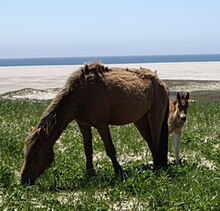Sable Island horse

Feral Sable Island Horses
|
|
| Country of origin | Sable Island, Canada |
|---|---|
| Traits | |
| Distinguishing features | Small, stocky feral horses |
The Sable Island Horse, sometimes referred to as the Sable Island Pony, is a type of small feral horse found on Sable Island, an island off the coast of Nova Scotia, Canada. It is a small type, often pony sized, but with a horse phenotype and horse ancestors, and usually dark in color. The first horses were released on the island in the late eighteenth century, and soon became feral. Additional horses were later transported to improve the herd's breeding stock. They were rounded up for private use and sale for slaughter, which by the 1950s had placed them in danger of extinction.
In 1960, the Canadian government protected the horses by law in their feral state. From the 1980s on, long-term, noninvasive herd studies have been performed, and in 2007 a genetic analysis was conducted that concluded the herd was genetically unique enough to interest conservationists. In 2008, the horses were declared the official horse of Nova Scotia, and in 2011, the island was declared the Sable Island National Park Reserve. The herd is unmanaged, and legally protected from interference by humans. The horses live only at Sable Island and at the Shubenacadie Wildlife Park on the mainland of Nova Scotia, with the latter herd descended from horses removed from Sable Island in the 1950s.
The horses that remain on Sable Island are feral. They generally stand between 13 and 14 hands (52 and 56 inches, 132 and 142 cm). Males from the island average about 360 kilograms (790 lb) and females about 300 kilograms (660 lb). The available food on the island limits their size, and the offspring of horses removed from the island and fed more nutritious diets are generally larger. Physically, the horses resemble Spanish horses, with arched necks and sloping croups. Overall, they are stocky and short, with short pasterns that allow them to move easily on sandy or rough ground. Sable Island horses have very shaggy coats, manes and tails, especially during the winter. The tail is full and low-set. Their coats are mostly dark colours, but some do have white markings. About half are bays, with the rest distributed among chestnut, palomino and black. Many Sable Island Horses have a natural ambling gait. Prior to their protection, when they could be kept for the use of humans, the horses were known for their sure-footedness and gaits.
...
Wikipedia
